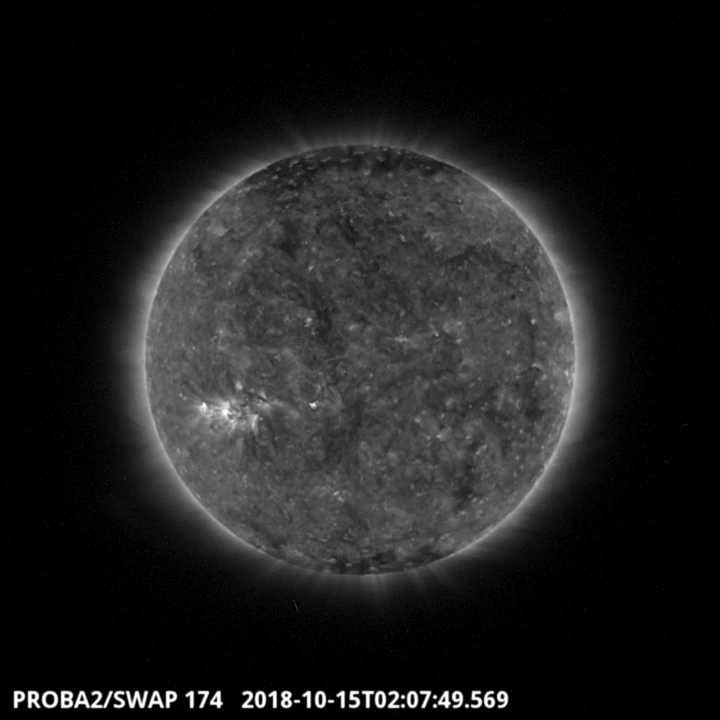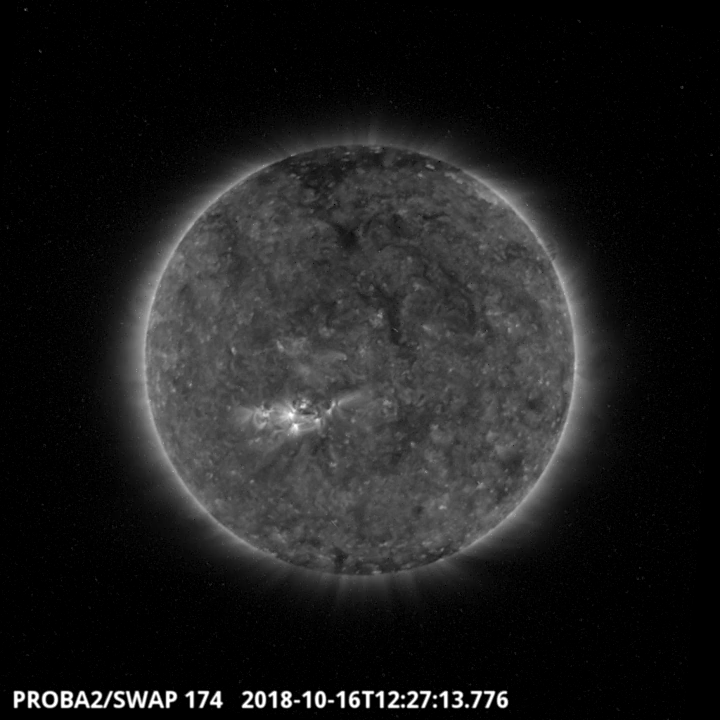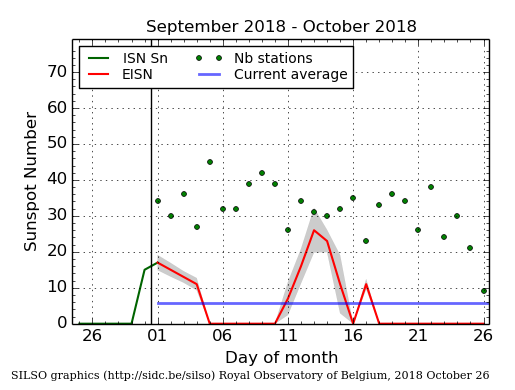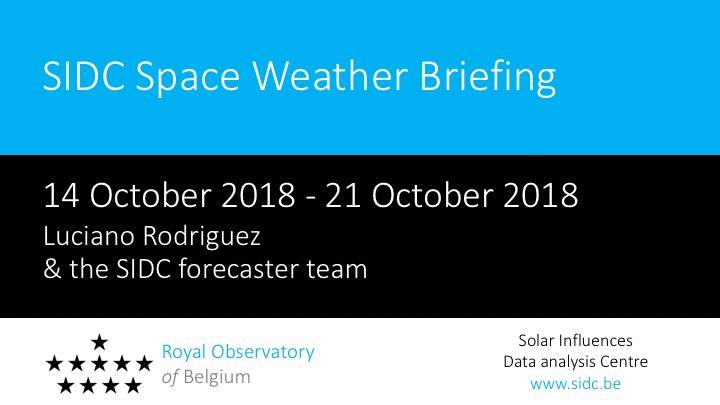- Table of Content
- 1.ESWW15 Live sp...
- 2.ESWW15 - User ...
- 3.PROBA2 Observa...
- 4.Review of sola...
- 5.The Internatio...
- 6.Review of geom...
- 7.Geomagnetic Ob...
- 8.SIDC space wea...
- 9.Review of iono...
2. ESWW15 - User Guide to the parallel sessions
3. PROBA2 Observations (15 Oct 2018 - 21 Oct 2018)
4. Review of solar activity
5. The International Sunspot Number
6. Review of geomagnetic activity
7. Geomagnetic Observations at Dourbes (15 Oct 2018 - 21 Oct 2018)
8. SIDC space weather briefing
9. Review of ionospheric activity (15 Oct 2018 - 21 Oct 2018)
ESWW15 Live space weather forecast: Call
Dear ESWW15 Participants
Those of you who regularly attend European Space Weather Week will I hope remember the daily Live Space Weather Forecasts that we have initiated to help us think about the real world impact of Space Weather and how we as a community can improve our communication of these complex issues to the wider public.
The format of the Live Space Weather Forecast event has evolved through the years, it is a chance to experiment with different ideas about communicating. In previous years the major Space Weather forecasting agencies have shared the responsibility of providing the daily forecasts, with each providing the whole forecasts for the particular day allocated to them.
This year we want to try something a bit different.
* We widen the call for forecasters, so that any interested agency or group can provide a forecast;
* Rather than a ‘general’ forecast, the forecast should be focused towards a specific user domain (aviation, satellite, power grid….) as chosen by the presenter.
* The forecast should be of no more than five minutes duration.
* It will be presented in a separate room at KU Leuven in the morning (there will be forecasts on Tuesday, Wednesday, Thursday and Friday – potentially one or two per day) and filmed by the KULeuven Local Organizing Committee. Live public is allowed.
* The recording will then be shown throughout the remainder of the day in the coffee area.
We would like to invite you to volunteer to contribute one of the Live Space Weather Forecasts at ESWW15.
If you are interested in doing so please send an email to ecla@bgs dot ac dot uk, i.e. Ellen before October 30 giving the following details:
* The name(s) of those who will give the presentation;
* Your affiliation / organization;
* Your preferred date (Tuesday, Wednesday, Thursday or Friday) for your forecast;
* The domain you target (eg: aviation, satellite, power grid….).
* We look forwards to meeting you at ESWW15 and enjoying your forecasts!!
Ellen Clarke, Dave Pitchford and Petra Vanlommel, on behalf of the Programme Committee
ESWW15 - User Guide to the parallel sessions
On Monday, Wednesday and Friday, 3 sessions run parallel. We want to help you to make a choice.
The User Guide to the parallel sessions includes 3 30'rounds. Each round consists of
* Informative speeches from the session ambassadors,
* Hearing of the public,
* Participants take a decision, with help of a sophisticated tool.
You are all invited to come to the live event 'User Guide to the parallel sessions' on Monday Nov 5, 10:00, Promotion room in the university halls (near the registration desk).
more on: http://www.stce.be/esww15/tutorial.php
Luke and Petra, on behalf of the session conveners

PROBA2 Observations (15 Oct 2018 - 21 Oct 2018)
Solar Activity
Solar flare activity was very low during the week.
In order to view the activity of this week in more detail, we suggest to go to the following website from which all the daily (normal and difference) movies can be accessed: http://proba2.oma.be/ssa
This page also lists the recorded flaring events.
A weekly overview movie can be found here (SWAP week 447).
http://proba2.oma.be/swap/data/mpg/movies/weekly_movies/weekly_movie_2018_10_15.mp4
Details about some of this week’s events, can be found further below.
If any of the linked movies are unavailable they can be found in the P2SC movie repository here.
http://proba2.oma.be/swap/data/mpg/movies/
Monday Oct 15

There were two active regions present on the disk at the beginning of the week, both are visible to the South-east of the solar disk in SWAP image above, from 2018-Oct-15. Both Active Regions were quiet and didn’t produce any flares. Find a movie of the events here (SWAP movie)
http://proba2.oma.be/swap/data/mpg/movies/20181015_swap_movie.mp4
Tuesday Oct 16

A low latitudinal extension of the northern polar coronal hole traversed the central meridian on 2018-Oct-16. Find a movie of the event here (SWAP movie).
http://proba2.oma.be/swap/data/mpg/movies/20181016_swap_movie.mp4
Review of solar activity
NOAA ARs 2724 and 2725 were the active regions present on the disk at the beginning of the week. NOAA AR 2724 decayed into a plage already on October 16, and 2725 did so the day after (although it returned on October 18, only for a day).
There were no C-class flares, no Earth directed CMEs and no proton events. This section could also have been called: Review of absence of solar activity.
The only excitement came from 2 coronal holes. A large negative polarity coronal hole crossed central meridian on October 10, and the low latitudinal extension of the northern polar coronal hole (positive polarity) traversed central meridian on October 16.
The International Sunspot Number

The daily Estimated International Sunspot Number (EISN, red curve with shaded error) derived by a simplified method from real-time data from the worldwide SILSO network. It extends the official Sunspot Number from the full processing of the preceding month (green line). The plot shows the last 30 days (about one solar rotation). The horizontal blue line shows the current monthly average, while the green dots give the number of stations included in the calculation of the EISN for each day.
Review of geomagnetic activity
At Dourbes, the geomagnetic conditions reached active levels between 21:00 UT and 22:00 UT on October 15, i.e. K=4. At the planetary level, unsettled conditions were recorded at planetary levels, i.e. Kp=3.
This was due to the high speed stream from the large negative polarity coronal hole that crossed the meridian on October 10. The solar wind had a speed around 600 km/s. The Bz component of the Interplanetary Magnetic Field went down to -5 nT.
The rest of the week, the geomagnetic conditions were quiet to unsettled. The high speed stream from the low latitudinal extension of the northern polar coronal hole (positive polarity) passed north of the Earth, producing only unsettled conditions.
SIDC space weather briefing
The Space Weather Briefing presented by the forecaster on duty from Oct 15 to 21. It reflects in images and graphs what is written in the Solar and Geomagnetic Activity report.

In pdf-format: http://www.stce.be/briefings/20181022_SWbriefing.pdf
An automatically running presentation: http://www.stce.be/briefings/20181022_SWbriefing.ppsm
Review of ionospheric activity (15 Oct 2018 - 21 Oct 2018)

The figure shows the time evolution of the Vertical Total Electron Content (VTEC) (in red) during the last week at three locations:
a) in the northern part of Europe(N61°, 5°E)
b) above Brussels(N50.5°, 4.5°E)
c) in the southern part of Europe(N36°, 5°E)
This figure also shows (in grey) the normal ionospheric behaviour expected based on the median VTEC from the 15 previous days.
The VTEC is expressed in TECu (with TECu=10^16 electrons per square meter) and is directly related to the signal propagation delay due to the ionosphere (in figure: delay on GPS L1 frequency).
The Sun's radiation ionizes the Earth's upper atmosphere, the ionosphere, located from about 60km to 1000km above the Earth's surface.The ionization process in the ionosphere produces ions and free electrons. These electrons perturb the propagation of the GNSS (Global Navigation Satellite System) signals by inducing a so-called ionospheric delay.
See http://stce.be/newsletter/GNSS_final.pdf for some more explanations ; for detailed information, see http://gnss.be/ionosphere_tutorial.php
